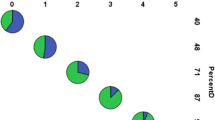Abstract
This article examines issues in juvenile justice that include public opinion about the causes and the consequences of juvenile crime and violence. Data for the study were collected in 1996 by means of a telephone survey of 492 respondents from Shelby County, Tennessee. The study explores the relationships between attitudes about juvenile crime and sociodemographic factors. Results are consistent with national surveys aimed at assessing public attitudes toward issues in juvenile justice. Finally, the article discusses how survey instrumentation may influence responses regarding the issues surrounding juvenile crime and violence.
Similar content being viewed by others
References
Ayidiya, S. A., & McClendon, M. J. (1990). Response effects in mail surveys.Public Opinion Quarterly 54, 229–247.
Baron, S. W., & Hartnagel, T. F. (1996). “Lock ’em up:” Attitudes toward punishing juvenile offenders.Canadian Journal of Criminology, April, 191–212.
Benton, J. E., & Daly, J. L. (1991). A question order effect in a local government survey.Public Opinion Quarterly, 55, 640–642.
Cullen, F. T., Wright, J. P., Brown, S., Moon, M. M., Blankenship, M. B., & Applegate, B. K. (1998). Public support for early intervention programs: Implications for a progressive policy agenda.Crime and Delinquency, 44(2), 187–204.
Elam, S. M., Rose, L. C., & Gallup, A. M. (1994). The 26th annual Phi Delta Kappa/ Gallup Poll of the public’s attitudes toward the public schools.Phi Delta Kappan, 76(1), 42–53.
Forde, D. R. (1993).Winnipeg Area Study, 1993. [Machine readable data file]. Winnipeg: University of Manitoba.
McFarland, S. G. (1981). Effects of question order on survey responses.Public Opinion Quarterly, 45, 208–215.
McGuire, K., & Pastore, A. L.(Eds.) (1997).Sourcebook of Criminal Justice Statistics 1996. Washington, DC: Government Printing Office.
Narayan, S., & Krosnick, J. A. (1996). Education moderates some response effects in attitude measurement.Public Opinion Quarterly, 60, 58–88.
Nitschke, L. (1996, July). Democrats stall consideration of juvenile crime bill.Congressional Quarterly, 2056.
Opinion Research Corporation. (1982).National Public Opinion Survey: Public attitudes toward youth crime. Minneapolis: University of Minnesota, Hubert Humphrey Institute of Public Affairs.
Rossi, P. H., Simpson, J. E., & Miller, J. L. (1985). Beyond crime seriousness: Fitting the punishment to the crime.Journal of Quantitative Criminology, 1, 59–90.
Schwartz, I. M., Abbey, J. M., & Barton, W. H. (1990).The perception and reality of juvenile crime in Michigan. Ann Arbor, MI: Center for the Study of Youth Policy.
Schwartz, I. M., Guo, S., & Kerbs, J. J. (1992). Public attitudes toward juvenile crime and juvenile justice: Implications for public policy.Hamiline Journal of Public Law and Policy, 13(2), 241–251.
Schwartz, I. M., Guo, S., & Kerbs, J. J. (1993). The impact of demographic variables on public opinion regarding juvenile justice: Implications for public policy.Crime and Delinquency, 39(1), 5–28.
Schuman, H., & Presser, S. (1996).Questions and answers in attitude surveys: Experiments on question form, wording, and context. Thousand Oaks, CA: Sage.
Sheley, J. F. (1985).America’s crime problem. Belmont, CA: Wadsworth.
Skovron, S. E., Scott, J. E., & Cullen, F. T. (1989). The death penalty for juveniles.Crime and Delinquency, 35, 546–561.
Snyder, H. N., & Sickmund, M. (1995).Juvenile offenders and victims: A national report. Washington, DC: Office of Juvenile Justice and Delinquency Prevention.
Steinhart, D. (1988).N.C.C.D. Focus — California Opinion Poll: Public attitudes on youth crime. San Francisco: National Council on Crime and Delinquency.
Stinchcombe, A. L., Adams, R., Heimer, C. A., Scheppele, K. L., Smith, T. W., & Taylor, D. G. (1980).Crime and punishment — Changing attitudes in America. San Francisco: Jossey-Bass.
US Department of Justice (1997).Uniform Crime Report: Crime in the United States, 1996. Washington, DC: Government Printing Office.
Author information
Authors and Affiliations
Rights and permissions
About this article
Cite this article
Hart, T.C. Causes and consequences of juvenile crime and violence: Public attitudes and question-order effect. AJCJ 23, 129–143 (1998). https://doi.org/10.1007/BF02887287
Issue Date:
DOI: https://doi.org/10.1007/BF02887287




